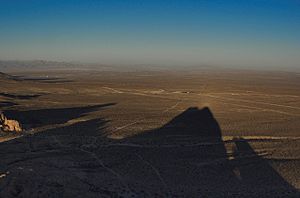Freeman Junction, California facts for kids
Quick facts for kids
Freeman Junction
Freeman's Junction (c.1800 - c.1920)
|
|
|---|---|

Overlooking the area where Freeman Junction once stood. The town of Ridgecrest is visible in the background
|
|
| Nickname(s):
A Town With Two Pasts
|
|
| Country | United States |
| State | California |
| County | Kern County |
| Reference #: | 766 |
Freeman Junction is a ghost town located in Kern County, California, USA. A ghost town is a place where almost no one lives anymore. This spot was first settled in the early 1870s. It became an important stop for travelers crossing the desert.
A man named Freeman S. Raymond built a stagecoach station here. This station helped people traveling between the desert mines and Los Angeles. In 1909, the original station was burned down. For several years, the area was empty. Later, in the 1920s, a new family, Clare C. Miley and his wife, settled here. Their small stone cabin grew into a gas station and car repair shop. It even became a restaurant and a center for some mining activities.
In 1953, there were plans for a post office, but it was never built. Residents had to travel to a nearby town to get their mail. By 1978, Freeman Junction was empty again. Over time, all the buildings and remains of the town disappeared. Today, the land looks just as it did before anyone settled there.
Contents
A Look Back at Freeman Junction's Past
Early Days and Native American Camps
Long ago, this area was a regular camping spot for Native Americans. You can still find special rocks called bedrock mortars near the original spring. These were used to grind food.
Explorers and Gold Seekers
In 1834, an explorer named Joseph R. Walker traveled through this area. He had just crossed the Sierra Nevada mountains using a path now called Walker Pass. Later, in the winter of 1849–50, groups of gold seekers known as the Death Valley '49ers passed through here. They were on their way to the California gold fields after escaping Death Valley.
The Stagecoach Station
Around 1873 or 1874, Freeman S. Raymond built his stagecoach station at this important crossroads. Raymond was one of the original gold seekers from 1849. The station was located where the Walker Pass road met the road to Los Angeles. Today, these are modern California 178 and California 14.
Both roads were busy with people and goods traveling to and from the many mines in the area. The Walker Pass road led to the Kern River mines. The Los Angeles road went further north and east to famous mines like Cerro Gordo, the Panamints, and later Darwin and Bodie.
A Famous Incident at the Station
On February 25, 1874, a well-known group led by Tiburcio Vasquez had an encounter at Raymond's station. They had watched the area from a nearby rock formation, which is now called Robber's Roost. The group surprised and took items from some freight wagons and a stagecoach that arrived at the station.
The Station's Later Years
Freeman Raymond continued to run the stagecoach stop. After 1889 or 1890, a post office was also added to the station. Raymond operated the station until he passed away in August 1909. The station building burned down a few years later. Today, the Los Angeles Aqueduct, which carries water to Los Angeles, passes through this historic site.
California Historical Landmark
A special marker, California Historical Landmark #766, is located nearby. It stands beside California 178, close to the junction with California 14. This monument tells a bit of the area's history:
- Explorer Joseph R. Walker passed this spot in 1834.
- Gold seekers from 1849 also came through here.
- The famous group led by Tiburcio Vásquez was active here. They often waited for stagecoaches and freight wagons traveling to and from the mines.



